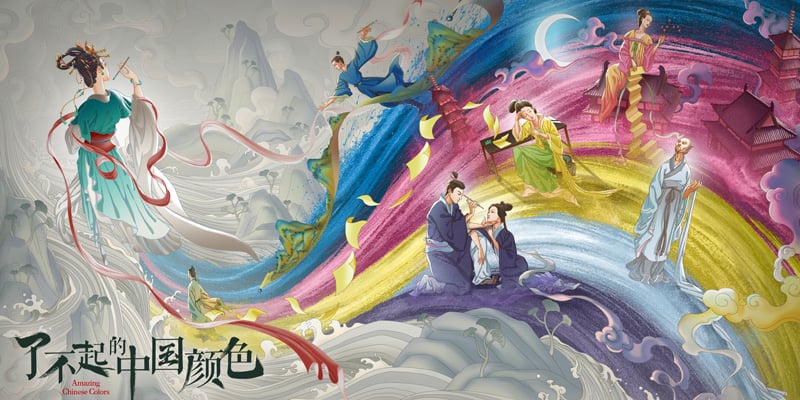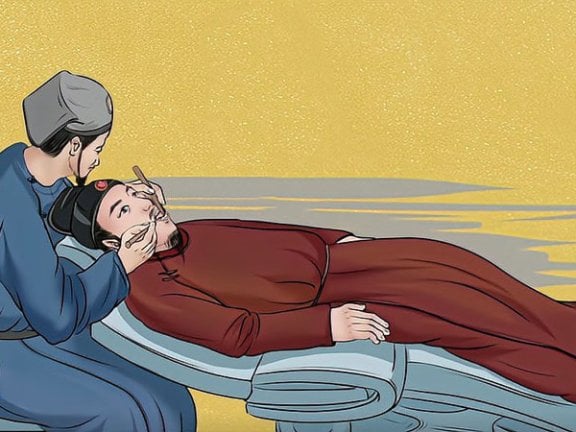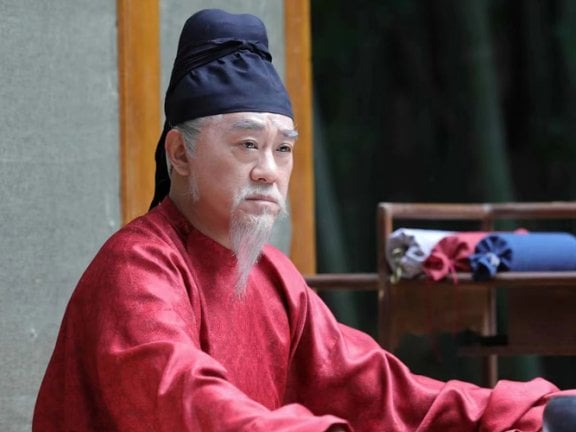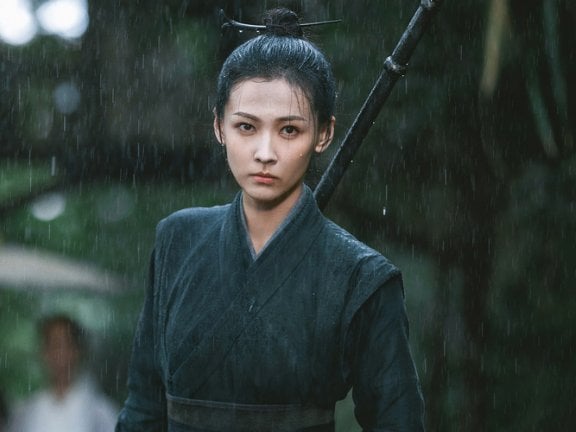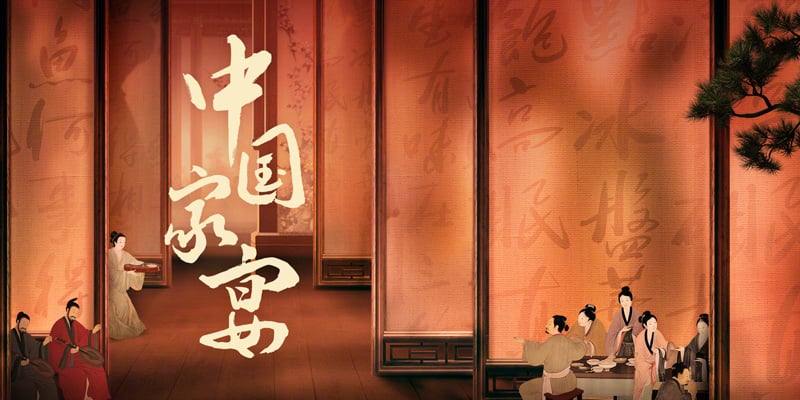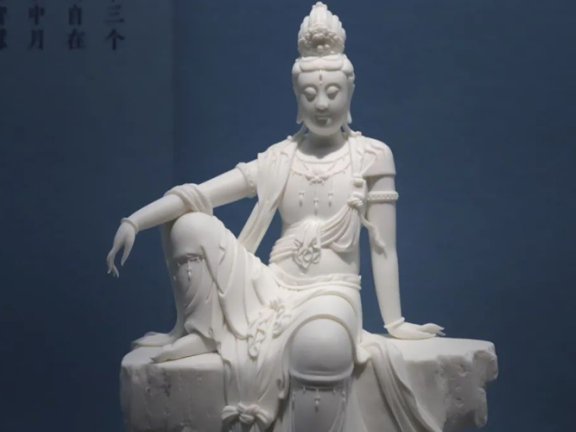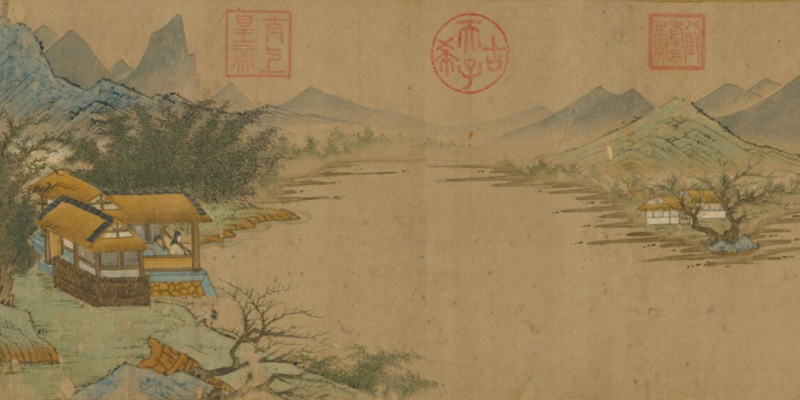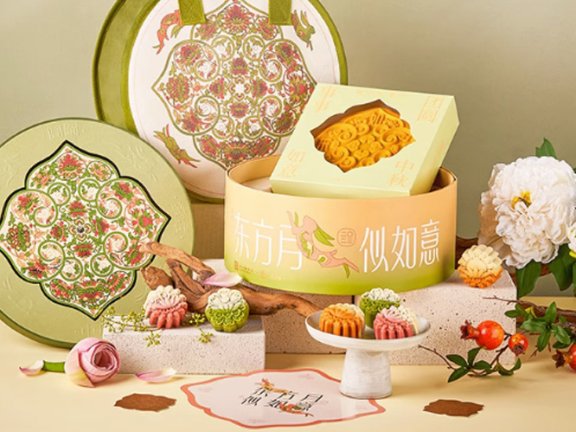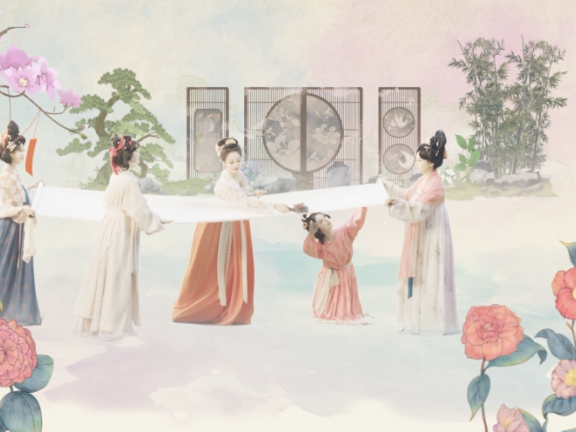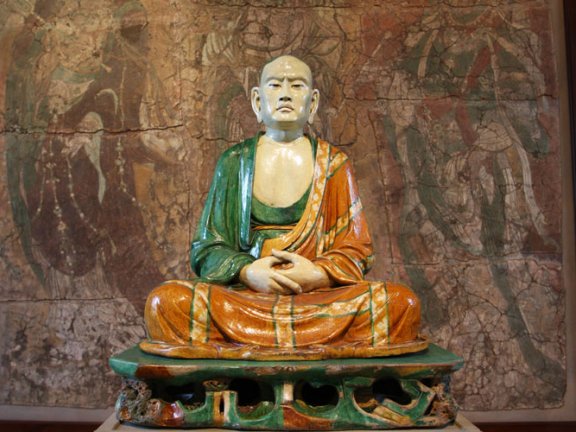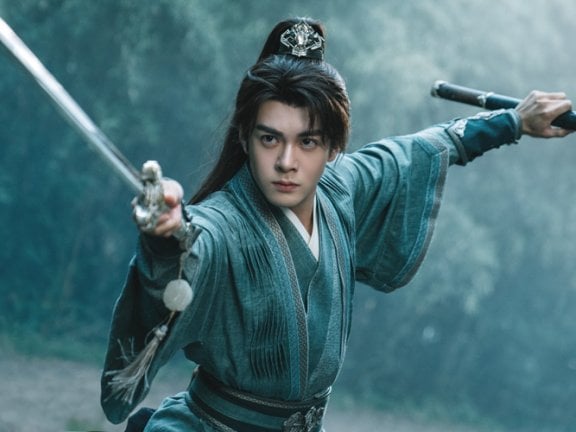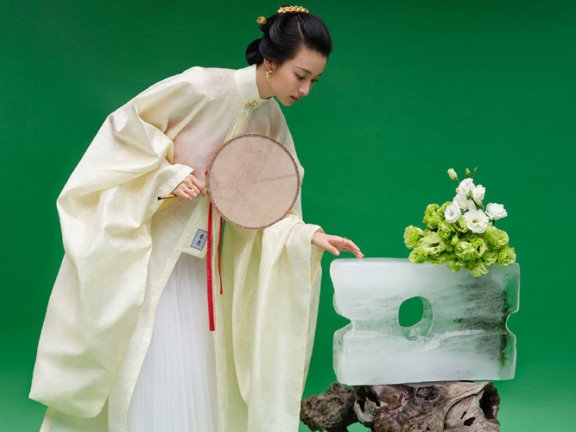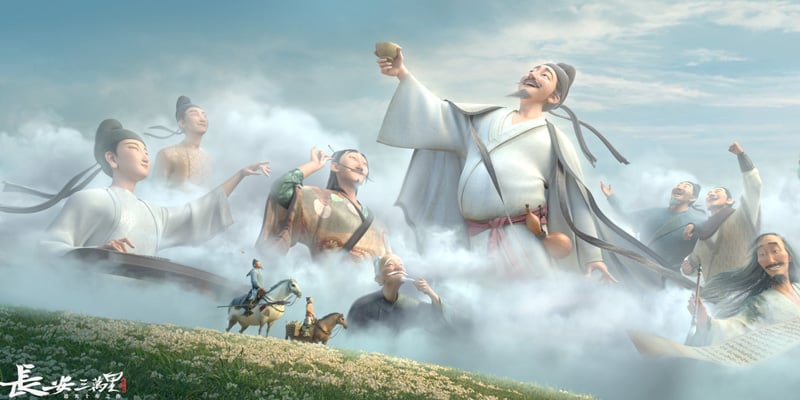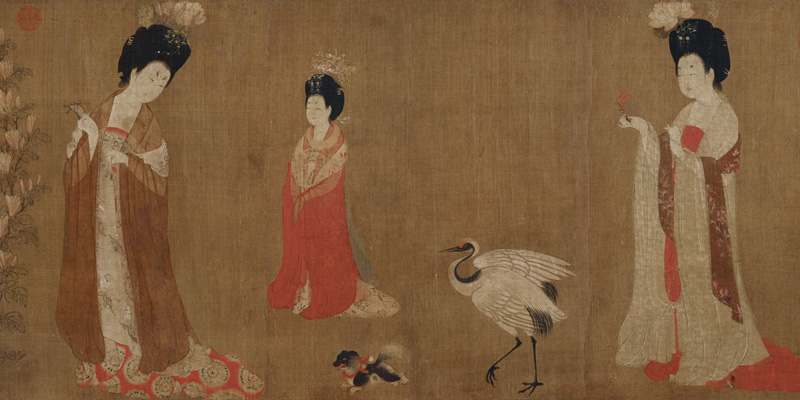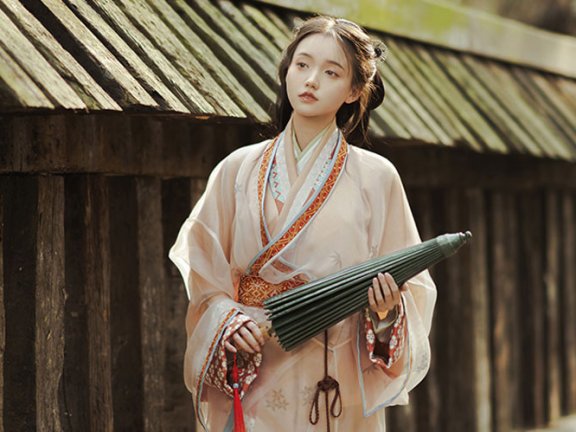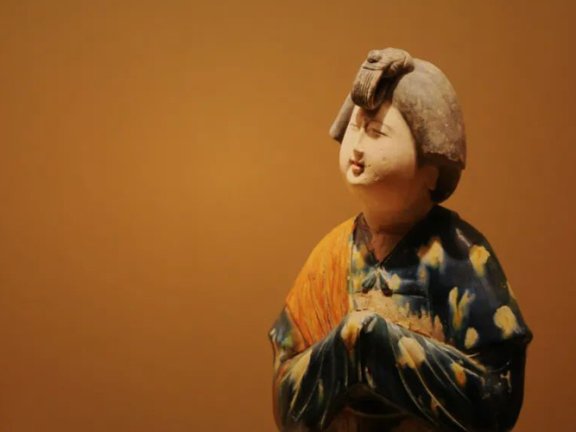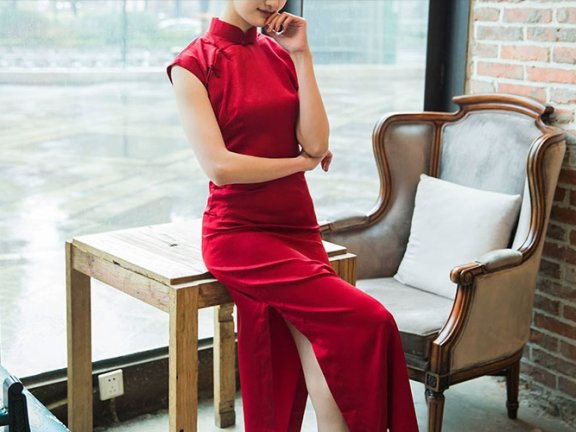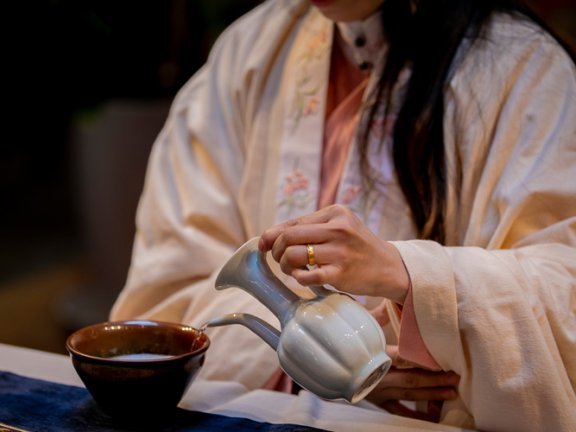-
Amazing Chinese Colors: Documentary Explores the Cultural Legacy of Traditional Hues
Different traditional colors in China are all uniquely named. Why are traditional colors in China named in this way? Since the Tang Dynasty, ancient people used the term "Yan Se (颜色)" as a general term for the colors in nature, giving colors names based on natural phenomena. Unlike the Western classification of primary colors, China divides colors into five main colors: "Chi (赤, red), Huang (黄, yellow), Qing (青, green), Hei (黑, black), and Bai (白, white)". As the seasons change, colors also transform and blend in countless variations. The recently released documentary series "Amazing Chinese Colors" takes traditional Chinese colors as a starting point to showcase the world of colors. "Amazing Chinese Colors" selects five traditional Chinese colors, and as a point of reference, five artists, namely Zeng Li, Zhang Yifan, Xuan Lu, Jiang Mengjie and Zhang Li, as the recommenders, dig out the history and culture related to such colors, extend the use of such colors in modern oriental aesthetics, show the infinite charm of traditional Chinese colors in the trend, and take the story of each color as the source of inspiration, to create unique traditional Chinese colors in the program. With each color story as the… -
Cozying Up in Antiquity: Exploring the Winter Heating Methods of Ancient China
In ancient China, the harsh winter cold was often a challenge, especially in regions where winters were long and frigid. However, the ancient Chinese people, with their wisdom and creativity, developed a series of unique and effective methods of keeping warm. These methods not only reflected the progress of ancient Chinese society and technology but also demonstrated their profound understanding of and adaptation to the natural environment. From braziers to fireplaces, from underfloor heating to ingeniously designed clothing, the heating methods of ancient China were the crystallization of wisdom in the face of cold. 01 Fur The most direct way for the human body to keep warm is to dress thickly, and the most natural and effective fabric is animal fur. This is also an indicator we use to determine the changing seasons in historical dramas - whether the main characters are wearing fluffy costumes, indicating that it is cold in the drama. A large number of historical dramas have contributed to the production of various styles of furry costumes. In fact, the winter clothing of ancient people was more exquisite and complete than the costumes in dramas. They would wear warm hats, fur jackets, cloaks, woolen socks, and… -
Dental Health in Ancient Asian Cultures: How Did They Maintain Their Teeth?
Oral health has always been important in the rich fabric of human history. The way ancient civilizations approached dental care provides us with a fascinating glimpse into the diverse practices that shaped the maintenance of healthy teeth over centuries. In this exploration, we turn our attention to the oral hygiene habits of ancient Asian cultures, seeking to unravel the secrets behind their enduring smiles. From herbal remedies to unique techniques, these societies employed a variety of methods to ensure their dental well-being, leaving behind a legacy that continues to intrigue and inspire. The Nightly Ritual Among the intriguing practices of ancient Asian cultures was their commitment to a comprehensive nightly dental routine. Imagine stepping back in time and observing the meticulous care individuals took before drifting into the realm of dreams. In the quiet hours of the evening, an ancient Asian might have engaged in a ritual that involved not just cleaning but also aligning their teeth. It’s like nighttime aligners but crafted from natural materials like bamboo or animal bones and worn during sleep to encourage proper tooth alignment. This innovative approach to orthodontics speaks volumes about the emphasis placed on dental aesthetics even in ancient times. Herbal Elixirs… -
Eight Masters of the Tang and Song: The Grand Tang from Han Yu's Perspective
The program of "Eight Masters of the Tang and Song" unveils the magnificent and dramatic life story of a generation of grandmasters through the mode of "immersive real-life performance + cinematic filming + XR innovative presentation", and explores the moments of the birth of "Tang and Song masterpieces". Immersive real-life performance: The "Cultural Exploration Team" personally experiences the plot, with scenes built on real-life settings. Cinematic filming: Through techniques such as plot rhythm and camera movement, the visuals are crafted to have a cinematic texture, enhancing the artistic and aesthetic qualities of the work. XR innovative presentation: By combining reality and virtuality through computers, it brings the participants a seamless immersion between the virtual world and the real world. Let us follow the "Cultural Exploration Team" of the program "Eight Masters of the Tang and Song" and step into the depths of history to take a look at the experience of Han Yu in the great Tang Dynasty. Han Yu lost his parents at a young age. At the age of 12, his older brother Han He passed away in Shaozhou, and Han Yu returned to Heyang with his sister-in-law to bury his brother. Since then, the burden of supporting… -
The Origins of Xia: Tracing the Evolution and Relevance of Chivalrous Ideals
What is Xia? Some say they are skilled warriors, others say they are outsiders on the fringes of society, and some even say it is an adult fairy tale. A knight-errant can take on many forms, but one thing is certain: from the moment they step onto the stage of history, their extraordinary allure ensures that the concept of a "Xia" will never fade away. What is Xia? Who can be called a knight-errant? To answer these questions, let us first go back to the Spring and Autumn Period and the Warring States Period, when knights-errant roamed. 01 When did ancient China have Xia? During the Pre-Qin period, warfare was frequent. One day, the powerful state of Chu was preparing to attack the weak state of Song and hired the renowned craftsman Lu Ban to create siege weapons. The military strength of Song was far inferior to that of Chu, and the people were filled with fear, scattering in all directions in an attempt to escape. Mozi, who had a deep background in craftsmanship and was skilled in defending cities, received this news and immediately rushed thousands of miles to the capital of Chu, hoping to utilize his expertise… -
Chinese Banquets: A Modern Narrative of Song Dynasty Culture
In the vast river of history, each dynasty has left its unique cultural imprint and artistic lifestyle. Among the many dynasties, the Song Dynasty, with its distinctive cultural charm and refined way of life, has become an indispensable chapter in Chinese history. Its delicacy, tolerance, and openness endowed this era with unparalleled artistic and cultural allure. Recently, Henan TV launched "Chinese Banquets." This cultural documentary takes us back to the Song Dynasty, a time filled with cultural atmosphere and artistic lifestyle, where the banquet rituals reconnect us with the ancient tranquility and elegance amidst the modern hustle and bustle. Background of "Chinese Banquets" From ancient times to the present, whether it is the noble emperors and nobles or the common people, on special holidays or significant occasions, banquets are hosted to entertain honored guests or close relatives and friends as a sign of respect. The Chinese banquet has become an etiquette of hospitality. "Chinese Banquets" extends the concept of Chinese festivals and, as a member of the cultural family, it reconstructs and reenacts Chinese dining rituals, exploring the Eastern sense of ritual, Eastern aesthetics, and Eastern wisdom associated with food. Features of "Chinese Banquets" While recreating the scenes of…- 0
- 0
- 45
-
Coursework About the History of Ancient China: Through the Eyes of a Student
We're talking ancient China here, the real deal of human civilization. This isn't just about learning who did what in some dusty past. It’s about diving into a saga so epic, it makes Game of Thrones look like child's play. Ancient China isn’t just another chapter in a textbook; it’s the bedrock of modern civilization. We’re talking about the birthplace of everything from gunpowder to paper money. This is where strategy was born, where Sun Tzu wrote ‘The Art of War’ – a book that business moguls are still geeking over. Each dynasty, from the Shang to the Qing, is a piece of a massive jigsaw puzzle. You’re connecting the dots, finding out how ancient decisions shaped modern life. Think of it as detective work, but instead of a crime, you’re solving the riddles of time. By the end of this wild ride, you’re not just loaded with facts; you’ve got wisdom. You’ll see patterns in politics, in culture, in human nature that echo even today. The Student's Perspective This student, let’s call them the Time Traveler, they’re not signing up for a snooze fest. They’re expecting Indiana Jones meets Confucius. They want to unearth secrets, to crack open the… -
The Timeless Appeal of Chinese Porcelain - A Fascinating Journey through Centuries of Ceramic Mastery
When we mention Chinese porcelain, perhaps you will associate it with the simplicity and profoundness of Ru kiln, the lustrous beauty of Ding kiln, and the natural elegance of Jun kiln. Your mind will conjure up one classic masterpiece after another. However, the "BLAND DE CHINE - Dehua Porcelain Exhibition" at the National Museum of China presents us with another aspect of porcelain. This artwork, created by a contemporary artist, breaks through our usual imagination of materials. It uses porcelain to simulate thin and translucent clothing, portraying the texture and folds of the garments flawlessly. The depiction of individual strands of hair is exquisitely detailed, leaving viewers in awe. The porcelain is made to resemble paper, even imitating the rough edges of paper to a remarkable degree. Even when magnified several times, it is difficult to discern that this is actually a piece of Chinese porcelain. In the long river of history, the skilled craftsmen of ancient China fully unleashed their imagination and created some porcelain pieces that deviate from our stereotypical impression of porcelain. Let us appreciate these Chinese porcelain pieces that are the least like porcelain. Stone or Porcelain During the Qing Dynasty, it was popular to… -
Discovering China's Historic Landmarks Attractions in Ancient Paintings
China has many historical ancient cities that are suitable for tourism: Beijing, Nanjing, Suzhou, and Hangzhou. However, the popular attractions in these popular tourist cities were already depicted by ancient artists. Let's take a journey into these ancient paintings together. Beijing Tiananmen was first built in the 15th year of the Ming Dynasty's Yongle reign. At that time, it was called "Chengtian Men," which symbolized "receiving the mandate of heaven and initiating an auspicious era." The name "Tiananmen" was given by Emperor Shizu of the Qing Dynasty when he ordered its reconstruction, meaning "receiving the mandate of heaven and ensuring peace and prosperity." As the main gate of the Beijing Imperial Palace during the Ming and Qing dynasties, Tiananmen, along with the Huabiao and stone lions beside the Jinshui bridge, has witnessed over six hundred years of historical changes. Centuries ago, there were already crowds of foreign envoys coming to pay tribute. After visiting Tiananmen Gate, the next stop must be the Yuanmingyuan Park. The Yuanmingyuan park was built during the Kangxi era and is a royal garden that represents the rise and fall of the Qing Dynasty. In the park, there are not only replicas of famous gardens… -
A Taste of Culture: Indulge in the Unique Mid-Autumn Mooncakes Crafted by Major China's Museums
The earthly lights and the moon in the sky, the most beautiful thing is reunion. As the Mid-Autumn Festival approaches once again, mooncakes are an indispensable part. A box of mooncakes is not only a delicious pastry that delights the taste buds, but also carries heartfelt wishes and folk stories. Museums across China have also presented creative mooncakes, incorporating the cultural treasures of Chinese heritage, adding a touch of romantic national aesthetics to the Mid-Autumn Festival. The Palace Museum In the collection of the Palace Museum, there is an imperial seal of Emperor Qianlong: "The moon is depicted with colors, water has sound". The brushwork is exquisite, capturing the scenery of the moon in the mountains and lakes. This year, the Palace Museum's mooncake gift box is inspired by this theme, combining traditional Chinese colors and dyeing techniques to appreciate the beauty of the country amidst mountains, rivers, and the moon. "Only the clear wind on the river and the bright moon in the mountains, the sound is heard in the ears, and the color is seen in the eyes." Take a bite of the Palace Museum mooncake, and the clear wind and bright moon will be in your…- 0
- 0
- 112
-
China’s Faded Holidays - Flower Festival
Introduction The Flower Festival (花朝节, huācháo jié), simplified as 花朝 (huācháo), is also known as the "Flower Goddess Festival (花神节, huāshén jié)," "Hundred Flowers’ Birthday (百花生日, bǎihuā shēngrì)," and "Flower Goddess’ Birthday (花神生日, huāshén shēngrì)." It is a festival where people can admire the blossoming flowers and show their respect for nature and the goddess of nature. The emergence of this flower festival has led to some confusions. Some claim it began during the Spring and Autumn Period, others during the Pre-Qin era, and some argue it emerged during the Tang Dynasty. The exact historical origins of this festival are not well-documented from the artifacts unearthed. Even with some historical records, it is still a challenge to pinpoint the exact dynasty for this festival. Perhaps they were called by a different name or a different festival slowly evolved into the flower festival known in the Tang Dynasty. What we can be certain of is that by the Tang Dynasty, the festival existed; whether it started before or during that period is still a matter of speculation. The earliest evidence of its existence dates back to the Spring and Autumn Period in the work of "táozhū gōngshū (陶朱公书)." Ancient Chinese society…- 1
- 2
- 120
-
Exploring the Chinese Artifacts Treasures Mentioned in Escape from the British Museum
The short drama "Escape from the British Museum" has become popular. This three-episode short video series, co-created by online media personalities Jianbing Guozai and Xiatian Meimei, is the most anticipated work in the film and television industry recently. It not only generated a lot of buzz on major online platforms but also received recognition and encouragement from numerous media outlets. Using personification as a narrative technique, it tells a sophisticated story: a delicate Chinese jade pot escapes from the British Museum and encounters a Chinese journalist named Zhang Yong'an, who is working overseas. They then embark on a journey back home together, fulfilling the task entrusted to her by the Chinese artifacts in the British Museum. With a total duration of less than 20 minutes, despite the insufficient maturity of its production elements such as scenes and props, the storytelling logic is complete, the emotions are abundant and solid, and the conveyed values are positioned at a very high level. It serves as a low-cost, high-level Chinese short drama model. After the release of the final episode, it directly sparked an explosive wave of praise. Many netizens were deeply moved by the scene where overseas cultural relics read letters to…- 1
- 0
- 103
-
Essence and Implies of Jianghu and Wuxia - Exploring the Martial World
The Wuxia drama "Mysterious Lotus Casebook" has attracted a large number of viewers since its premiere with its innovative martial arts format. The seemingly outdated elements of the martial arts world such as martial heroes, inns, and sects have broken through the traditional boundaries in the drama. However, when it comes to martial arts, one cannot ignore the concept of the Jianghu (江湖, rivers and lakes) in Chinese culture. What exactly is the Jianghu? How can we define the Jianghu culture? The term Jianghu seems to be a vague concept. People admire and yearn for the Jianghu, but it always seems difficult to define and is not considered highbrow. The earliest appearance of the term Jianghu can be found in the book "Zhuangzi": “相濡以沫,不如相忘于江湖。(Rather than leave them to moisten each other with their damp and spittle, it would be far better to let them forget themselves in their native rivers and lakes)” This phrase evokes a sense of imagination, encompassing the vast territories of the Central Plains, the four corners of the world, the rivers and lakes that crisscross the land. Gradually, the Jianghu has evolved into a metaphor for the world. The beauty brought forth by nature, the…- 2
- 0
- 159
-
Stunning Hanfu Photography that Transports You into the Glamorous World of Ancient China
The hanfu culture is no longer just a celebration for a small group of people; an increasing number of ordinary individuals are now sharing their hanfu experiences through creative short videos, integrating hanfu into their daily lives. At the same time, the seemingly unrelated realms of hanfu and fashion have also begun to merge. Hanfu covers in fashion magazines have sparked discussions within the hanfu community, fashion circles, and academic circles alike. Among them, we can find replicas, traditional designs, and fusion styles of hanfu. Dongjin Shangyu has compiled a collection of fashionable magazine spreads featuring hanfu throughout the years for you. Hanfu in 2013 "FHM" Ten years ago, social networks were not as active as they are today. However, even at that time these three photos broke through the aesthetic norms of the hanfu community and even attracted attention from the media industry. One of these works was used as a cover photo in Issue 112 of "CHINESE HERITAGE" magazine. At that time, Yu Lingyuan was responsible for this photoshoot and said: "The structure of Western suits is similar to Western sculpture - it is very complex in terms of craftsmanship and has a three-dimensional quality. However, what…- 1
- 0
- 102
-
Exploring the Rich Heritage of China through the Artifacts in Creation of the Gods
As a traditional mythological story, the plot of "Investiture of the Gods" is already well-known to us. However, "Creation of the Gods I: Kingdom of Storms" still prepared many surprises for the audience. For example, we can see the presence of many Chinese national treasure-level cultural relics in the props. 01 Horses In the Creation of the Gods, Yin Shou led his military to return triumphantly from Jizhou. The Shang King and Crown Prince Yin Qi sat on a chariot driven by six white horses to welcome them. It is well known that in ancient times, the number of horses and specifications of vehicles were important symbols of identity and status. There were strict ritual regulations regarding this throughout various dynasties. “天子驾六马,诸侯驾四、大夫三、士二、庶人一。” -《逸礼·王度记》 "The emperors rides with six horses; feudal lords ride with four; high-ranking officials three; scholars two; commoners one." - Yi Li · Wang Du Ji In addition to consulting ancient books, the film also referenced unearthed cultural relics - such as the discovery of a horse-drawn carriage pit called "Six Imperial Horses" at Luoyang He Luo Cultural Square in 2002. There are 26 buried carriages in total divided into two rows, with their heads facing south…- 1
- 1
- 109
-
History of Flying Apsaras Art: Symbolism and Significance in Cultural Heritage
In the Wei, Jin, and North-South Dynasties, when Buddhism was first spread, the flying immortals in the murals were once called Fei Tian (飞天, flying apsaras). With the deep development of Buddhism in China, the Buddhist flying gods and flying immortals merged with each other in artistic images. Dunhuang Fei Tian is the flying apsaras painted in the Dunhuang caves, which later became a special term for Chinese Dunhuang mural art. 01 Origin of flying apsaras In Buddhist culture, the term "Tian" not only refers to celestial abodes but also to the deities within them, such as the "Gongde Tian," which represents auspicious heavenly maidens. Within the heavenly realm, there exists a category of minor deities who flit about and attend to various matters for the apsaras. They possess exceptional singing and dancing abilities, and whenever the Buddha expounds upon his teachings, they soar through the air in graceful dances while playing music and scattering flowers. This imagery actually originated from two minor deities in Brahmanism - Gandharvas and Apsaras. The former is associated with music while the latter embodies dance. The early translators aptly rendered these minor deities as "Fei Tian," denoting their ethereal nature of soaring through…- 0
- 0
- 115
-
Hanfu Accessory: Wrapped Flower History and Chan Hua Basic DIY Steps
Vocab of Wrapped Flower Wrapped flower - 缠花 (chán huā) - a name used to called artificially made flower using the techniques of wrapping colored silk thread around cut-out pieces and combining each parts together to make flowers, animals, insects, etc. Spring Flower - 春仔花 (chūn zǐ huā) or 春花 (chūn huā). Used in this situation would mean various types of flower combined into a small batch each flower symbolize for different meanings in China. In this case, the flower would be a wrapped flower rather than a real flower. History of Wrapped Flower Through ancient China, people held a profound appreciation for nature, which manifested in their beliefs of deities who governed natural forces to their interest in making poetry, music, and artworks that represented the beauty they saw. One remarkable custom in ancient China were the flower hair-pinning practice known as "簪花的习俗 (zān huā de xí sú)," where both men and women adorned their hair or hat with flowers, either fresh or artificially made. Talking about flowers, there are many artificial flower craftsmen that have passed down for centuries, including "ronghua" and "wrapped flower." The art of wrapped flowers originated during the Ming Dynasty and arrived in the…- 4
- 2
- 457
-
A Fashion Journey Through Chang An: Exquisite Hanfu Traditional Motifs in the Movie
The animated historical film "Chang An," produced by Light Chaser Animation Studios and directed by Xie Junwei and Zou Jing, was released on July 8, 2023. Set against the backdrop of the prosperous Tang Dynasty, the film depicts the chaos that engulfed Chang'an after the An Lushan Rebellion. In this tumultuous time, Gao Shi reminisces about his past with Li Bai. What makes this film remarkable is not only its portrayal of a realistic and captivating Li Bai but also its presentation of the poignant stories between Li Bai and Gao Shi throughout their lives. It showcases their encounters with other prominent figures of the Tang Dynasty such as Du Fu and Wang Wei, capturing the splendorous era they lived in and showcasing the infinite charm of poetry and culture. Recently sparked heated discussions among netizens after its release. The film showcases the charm of Eastern aesthetics, allowing viewers to travel through time and experience the splendorous Tang Dynasty. In addition to the essence of Tang style emanating from poetry, the intricate motifs on the characters' costumes in the film also reveal the beauty of lines within China's long historical river. Patterns, simply put, refer to decorative designs. Ancient people drew…- 0
- 0
- 127
-
Unveiling Tang Dynasty Fashion Through Court Ladies Adorning Their Hair with Flowers
To truly understand the fashionable attire of Tang Dynasty women, one must not miss the renowned painting "Court Ladies Adorning Their Hair with Flowers". It is said that during the late 8th century in the Zhenyuan era, painter Zhou Fang created this masterpiece. This painting serves as a benchmark for ancient lady paintings and fully showcases the dressing essentials of fashionable Tang Dynasty women. Cctvnewscenter has made a fine interpretation of this painting, come and feel the charm of Tang Dynasty fashion. The great Tang Dynasty style In this painting, there are five ladies with adorning flowers and one maid holding a fan. Enjoying themselves amidst blooming flowers and elegant cranes, with two playful dogs nearby. The dressings of these Tang Dynasty fashion influencers not only emphasize color coordination but also pay attention to layering, exuding sophistication and ambiance. The women in the painting wear dresses made from yarn or silk, which were considered to be the most fashionable fabrics in Tang Dynasty. A strapless long skirt trails on the ground while transparent shawl wrap around both sides. Loose and comfortable wide sleeves, mainly in shades of red with various decorative patterns. Let's focus on these ladies: the second woman from…- 2
- 0
- 196
-
Capturing the Spirit of Qu Yuan: Exploration of the Iconic Chinese Poet
The Dragon Boat Festival (Duan Wu Festival, 端午节) is considered one of the oldest traditional folk festivals in China, alongside the Spring Festival, Qingming Festival, and Mid-Autumn Festival. According to records, the Dragon Boat Festival originated from the worship of celestial phenomena and evolved from ancient dragon rituals. The Dragon Boat Festival is an auspicious day associated with this imagery of a soaring dragon; thus, both dragons and dragon boat culture have always been an integral part of its historical legacy. The term "Duan Wu" itself first appeared in Fengtu Ji during the Jin Dynasty. However, nowadays when most people mention the Dragon Boat Festival, they often associate it with Qu Yuan's legend. Legend has it that on the fifth day of the fifth month of the lunar calendar, Qu Yuan tragically sacrificed himself by plunging into Miluo River out of loyalty to his country. Upon hearing this news, local villagers rushed to their boats to rescue him. Worried about their speed not being fast enough, they vigorously rowed while also fearing that fish would devour Qu Yuan's body, hence throwing rice dumplings into the river. Later on, people designated the fifth day of the fifth month of the lunar…- 1
- 0
- 180
-
The Enduring Legacy of Jiaoling Youren in China: History and Cultural Significance
The "Jiaoling Youren (交领右衽, cross-collar-and-right-wrapped, the left lapel covers the right lapel when wearing)" based on flat cutting is a typical collar that has been passed down in the Chinese civilization for thousands of years. It fully embodies the diverse and integrated pattern since ancient times, carries Chinese common cultural connotation as a nation, and is a symbol of the spiritual essence extracted from the long history of Chinese civilization. Chinese traditional costumes are profound and have a long history, Jiaoling Youren is like main threads linking thousands of years' of flowery clouds together to inherit continuously with boundless beauty. The character "衣 (clothing)" already existed in oracle bone script which reveals its structural feature: two lapels overlap each other forming into textual symbols. 01 What is Jiaoling Youren One of the most prominent features of Hanfu is the collar design that crosses left over right to form a "Y" shape known as the Jiaoling Youren style. This collar design has more than 5,000 years of history since Zhou Dynasty. Even though Hanfu keeps innovating with different styles such as straight collars, tank tops, and stand-up collars, the cross-collared Hanfu still maintains its mainstream position among these styles. …- 2
- 0
- 250
-
Guide of Tang Sancai: A Colorful Blend of Chinese Art and History
In 1904, the construction of the Bianluo Railway began. As a part of the later Longhai Railway, this transportation line passed through Mangshan to the north of Luoyang city, an ideal place for emperors, officials and civilians to choose their burial grounds since at least the Eastern Zhou Dynasty. The construction of modern railways undoubtedly broke the peace of another world, but it also allowed underground treasures to see daylight again. Among many damaged Tang tombs, a type of color-glazed ceramic funerary object that had never been seen before by people drew attention from antiquarians; this is "Tang Sancai". Since then, people have been indulging in the gorgeous and lustrous colors of Tang Sancai as if all the grandeur and majesty of Tang Dynasty were condensed into such an object. It was an era completely different from that during Qing Dynasty; gazing upon and playing with Tang Sancai might help one temporarily withdraw from chaotic times and dream peacefully in a book room filled with sandalwood aroma. The Legacy of the Tang Dynasty In fact, although they are called Tang Sancai, there is no record of such object names in historical documents. The name "Tang Sancai (唐三彩, Tang Tri-color…- 0
- 0
- 281
-
9 Common Misunderstandings about Cheongsams Debunked
As a typical representative of Chinese traditional clothing culture, cheongsam has fascinated people around the world with its outstanding form. Although there are still many disputes over the definition of cheongsam today, it remains one of the most splendid and formal dress cultures in China's long history. At first, the style of Chinese cheongsam had tight cuffs, narrowed edges, slightly embroidered patterns and slightly longer hemlines. In the late 1920s, influenced by Western skirts, cheongsam underwent more obvious changes, tightening waistline to highlight curves and simplifying decorations. Cheongsam became a fitted curve shape that first reflected women's features such as concave-convex lines and laid a foundation for today's basic characteristics and fashion trends in women's wear. After the 1930s and 1940s, Chinese cheongsam reached a perfect maturity in design becoming world-renowned classic attire - this was also the peak period for cheongsams. High-collared necklines with waists sucked-in tightly; short sleeves fastened with knots or buttons; slanting fronts often opened high on one side; some dresses were short while others were long; cutting styles followed western skirt designs emphasizing smoother lines which made Chinese Cheongsams fit better to display female beauty figures. When wearing a Chinese Cheongsam dress woman’s graceful figure…- 0
- 1
- 131
-
The Evolution of Three Chinese Tea Ceremonies: From Tang Dynasty to Modern Times
What is a tea ceremony? The book "Chinese Tea Ceremony", is explained as a cultural art that embodies the perfect combination of tea and culture, a means of cultivating oneself. However, when people mention tea ceremony, many think of the Japanese tea ceremony. Yet this ancient way of drinking tea has actually retained many Chinese Tang and Song dynasty customs. Over the past two thousand years, the way people drink tea has been constantly changing from simple to complex. It took Chinese people more than one thousand years to evolve from simplicity to complexity; then another one thousand plus years to return back to simplicity. Let us explore the Chinese tea ceremony by savoring a cup of warm tea soup while searching for flavors once tasted by our ancestors. 1 Tang Dynasty: The Art of Jian Cha Ceremony The most primitive way for Chinese people to taste tea was by eating it. Ancient people originally used tea leaves for medicinal and food purposes, boiling fresh leaves and consuming the liquid directly. Gradually, they discovered that tea had a refreshing effect on the body, leading to the development of cooking tea as a dish with added seasonings such as scallions,…- 0
- 0
- 244
